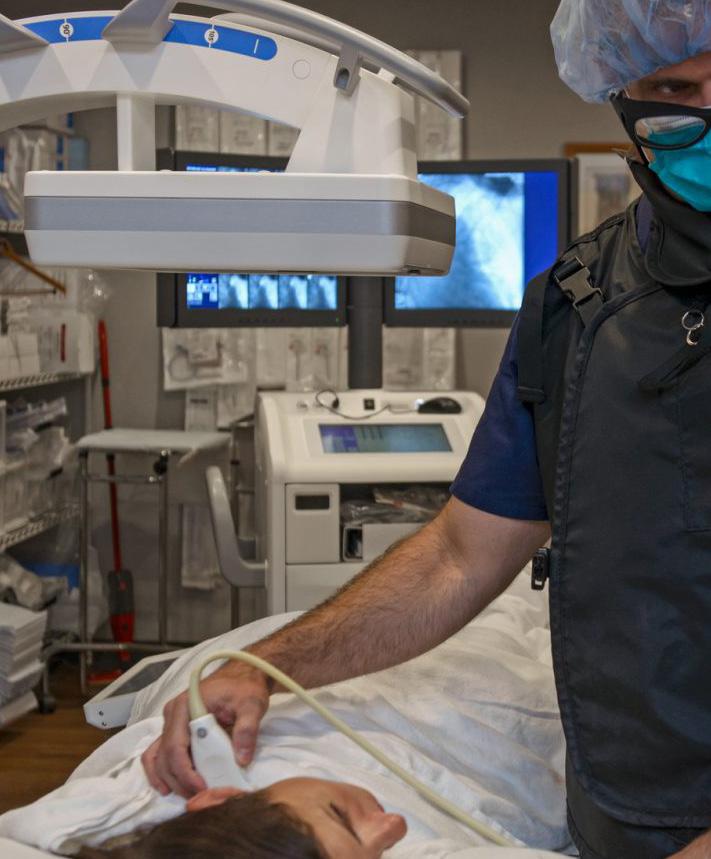
3 minute read
DIAGNOSTIC USES OF INTERVENTIONAL RADIOLOGY
6 DIAGNOSTIC USES OF
INTERVENTIONAL RADIOLOGY By: Hassan Abu-Shuqair
Advertisement
As of recent, groundbreaking advancements in the field of medicine have been achieved, it goes without saying that this has been mainly possible due to the revolutionary field of radiology. Not so long ago, radiology was referred to as simply; diagnostic imaging.
This definition was valid at a time when treatments were carried out separately from diagnostic procedures which were done mainly by radiologists. Until one day, a radiologist named Charles Dotter (1) asked a question that would go on to reshape medical practices; is it possible to use the same diagnostic imaging tools to guide the real-time treatment of disease?
The answer was yes, and later on this would set the foundation for the field of Interventional Radiology (IR). What distinguishes IR from other radiology subspecialties, is that it provides both diagnosis and treatment of disease through minimally invasive image-guided techniques.
The term image guided refers to the fact that any procedure done in IR mainly depends on real-time taken preoperative or intraoperative images. These images are generated via imaging techniques such as MRI (magnetic resonance imaging) scans, X-rays, fluoroscopy, CT (computed tomography) scans and ultrasounds. Most of these techniques are commonly used in other radiology subspecialties, for instance: neuroradiology, pediatric radiology, etc. However, their application in other subspecialties is mainly for diagnostic purposes, unlike IR which counts on their outputs in treatment procedures.
Nevertheless, there are other diagnostic methods which are more exclusively used by interventional radiologists such as:
1. Angiography: a technique which produces images by visualizing the internal lumen of blood vessels and body organs, mostly concerned with arteries, veins, and heart chambers (2) . This technique has several uses including: coronary angiography, fluorescein angiography, micro-angiography, neuro-vascular angiography , etc.
2. Biopsy: a test that involves the extraction of sample cells or tissues for inspection to determine the presence or dimensions of a disease (3) .
3. Cholangiography: an x-ray procedure that includes the injection of a contrast substance directly into the bile ducts inside the liver to produce pictures of the bile ducts (4) .
4. Cardiac catheterization: a procedure that involves the insertion of a thin catheter into a chamber or vessel of the heart. This technique is widely used for both diagnostic and interventional purposes.
Recent studies have indicated that various IR techniques are found to be clinically efficient in diagnosing and managing a very rare splanchnic venous abnormality; which is the congenital extrahepatic portosystemic shunt (CEPS)5. These methods include the plasticity of the intrahepatic portal system in type 1 shunts, while in type 2 shunts they are traditionally treated by endovascular treatment by coil or plug embolization. The main evaluation procedure in portomesenteric vasculature is conventional angiography. Considering that currently CEPS lacks standard treatment guidelines due to its rarity, IR relatively limited-risk methods will significantly help enhance the lives of CEPS patients5. Moreover, IR may be a promising turning point in the field of breast cancer interventions and diagnostic procedures. As previous studies have outlined that the opportunity exists for new research in ultrasound-guided biopsy of micro calcifications, stereotactic-guided lumpectomy, and ultrasound-guided ablation of breast cancer6. To conclude, Interventional Radiology without a doubt offers an excellent option for cases which would previously require critical surgical interventions. Whereas, nowadays IR with its minimally invasive procedures provides low risks, less pain and less recovery time in comparison to open surgeries. Further achievements are yet to be expected form IR and its wide implementations in the future.
References: ___________________
1- Payne MM. Charles Theodore Dotter. The father of intervention. Tex Heart Inst J. 2001;28(1):28–38. (paper) 2- Uberoi, Raman (2009). “4 Imaging”. Interventional radiology. Oxford New York: Oxford University Press. pp. 49–77. ISBN 978-0-19-157556-3. (book) 3- Uberoi, Raman (2009). “19 Biopsy and drainage”. Interventional radiology. Oxford New York: Oxford University Press. pp. 387–402. ISBN 978-0-19-157556-3. (book) 4- Ahmed O, Mathevosian S, Arslan B. Biliary Interventions: Tools and Techniques of the Trade, Access, Cholangiography, Biopsy, Cholangioscopy, Cholangioplasty, Stenting, Stone Extraction, and Brachytherapy. Semin Intervent Radiol. 2016;33(4):283–290. doi:10.1055/s-0036-1592327(paper). 5- Mathai SV, Kondray V, Salloum E, Kukreja K, Tavri S. Role of interventional radiology in the diagnosis and management of congenital extrahepatic portosystemic shunts: Two case reports. Indian J Radiol Imaging. 2019;29(2):219–222. doi:10.4103/ijri.IJRI_461_18 (paper). 6- Tomkovich KR. Interventional Radiology in the Diagnosis and Treatment of Diseases of the Breast: A Historical Review and Future Perspective Based on Currently Available Techniques. American Journal of Roentgenology. 2014;203(4):725-33. (paper)








